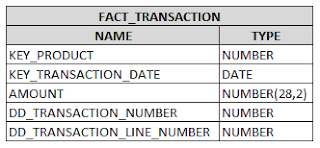1.) Junk Dimensions - The examples of junk dimensions that I have provided included the word "junk" in the name. Margy Ross suggests not naming it as such, which makes a lot of sense. Encountering a table with junk in the name may cause some confusion (perhaps even concern) for an analyst who is not well-versed in dimensional modeling.
2.) Snowflake Schema - The terms portion of my website provides the following definition for a snowflake schema
Occasionally there are reasons to join one dimension table to another dimension table. A schema in which this occurs is referred to as a snowflake schema. The ERD, in this case, will show this “second layer” of dimension tables as being similar in appearance to a snowflake.
This dimensional modeling class proved to me that this definition is a bit misleading. Joining one dimension table to another, such as the one on the terms portion of my website, is referred to as an outrigger. A snowflake schema involves an attempt to completely denormalize a dimension.
3.) Type 3 Slowly Changing Dimension - In this post, I described Type 3 slowly changing dimensions as being a hybrid between type 1 and type 2. In reality, this hybrid is actually referred to as a type 6 (I need to update the other post). So, what is a type 3 slowly changing dimension? I'll save that explanation for a future post; however, the type 3 is not the hybrid that I thought it was.
One of the advantages of attending a course like this is that you get to bounce your knowledge against some of the most brilliant minds in the industry. In some cases they help to affirm what you already know. In other cases they correct what you already "know"...which turns you into a stronger asset for your organization and for the industry.
For more information on data warehousing concepts visit www.brianciampa.com. For data that can be used to practice modeling and/or ETL, click on Career in Data Warehousing and then click Grow. Also, if you need a fresh approach to marketing your data warehousing skillset, consider The Data Warehouse Portfolio.
One of the advantages of attending a course like this is that you get to bounce your knowledge against some of the most brilliant minds in the industry. In some cases they help to affirm what you already know. In other cases they correct what you already "know"...which turns you into a stronger asset for your organization and for the industry.
For more information on data warehousing concepts visit www.brianciampa.com. For data that can be used to practice modeling and/or ETL, click on Career in Data Warehousing and then click Grow. Also, if you need a fresh approach to marketing your data warehousing skillset, consider The Data Warehouse Portfolio.






















